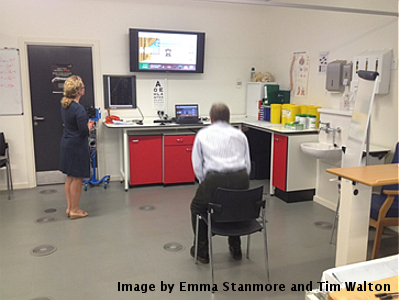Exergames - how to make physiotherapy fun
Posted on 12 February 2015
Exergames - how to make physiotherapy fun
 By Alina Călin, Chief Research Officer at MIRA Rehab, and Dr. Emma Stanmore, Lecturer in Nursing at the University of Manchester.
By Alina Călin, Chief Research Officer at MIRA Rehab, and Dr. Emma Stanmore, Lecturer in Nursing at the University of Manchester.
This article is part of our series: a day in the software life, in which we ask researchers from all disciplines to discuss the tools that make their research possible.
Gamification is the next big innovation in the field of rehabilitation, and makes use of remote sensors and aspects of video game design to engage patients in their rehab and make it more accessible, which in turn encourages participation and so keeps costs down.
Exergames was our attempt to develop this possibility, and is a successful collaboration between The University of Manchester, Central Manchester University Hospitals NHS Foundation Trust and MIRA REHAB Ltd. It lead to the development of several exergames, designed to use the Microsoft Kinect sensor, and all of which use exercises known to help prevent falls and improve function in older people.
Falls are a common problem for the UK’s ever growing ageing population. Every year, around 10% of older people are treated by a doctor due to a fall and approximately 100,000 older people in Europe die from a fall related injury each year, according to 2013 data by the European Association for Injury Prevention and Safety Promotion (Eurosafe).
The aims of the project were to develop exergames that took into account the views of older people to ensure that the designs were appropriate, attractive and at the right level in terms of speed and difficulty. Two focus groups made up of older people were held prior to the start of the design phase of the project, and, once completed, the exergames were tested on volunteers in a clinical environment by physiotherapists in order to gain feedback.
The exergames themselves were based on the FaME and Otago strength and balance exercise programme, which has been proven to reduce falls in older people. They were also built upon the clinical rehabilitation tool, MIRA. This contains a patient management component, designed for doctors and physiotherapists, and can store detailed patient files, including statistical data obtained during rehab sessions.
This data is of the utmost importance, as it offers adherence statistics, which is to say, the number of exergames played, along with their frequency and duration, and progress statistics, such as the number of points scored, distance, speed, acceleration and overall activity level during the games. At the time this project began, the platform contained some exergames, mainly for upper limb rehabilitation.
The feedback from the collaborators was very important, as the games were based on exercises that constitute best practice in terms of preventing falls. We also needed feedback regarding gaming and interaction preferences for older people, as they were the primary target. This challenge was easily overcome by using a natural interaction sensor, Microsoft’s Kinect, with an easy to understand intuitive interface and by creating games with a simple interface, interesting content and adapted dynamics.
The Kinect sensor is, of course, well known as a motion sensor in gaming circles, but it has also attracted interest amongst healthcare researchers. It is based on an RGB camera and two IR sensors that are able to detect and track human body joints even in poor light. Kinect is the base for all our exergames’ interactivity and provides important movement data that is processed and displayed in the form of statistics.
Three games incorporating four exercises were developed, using the .Net technologies, mainly C# and WPF, in order to provide a simple but pleasant interface for easy interaction as a desktop application.
The first of these is PowerHouse Bid, where the user needs to bid for the items they want to acquire, by standing up or down, requiring a sit-to-stand movement.

Izzy the Bee requires squats or hip abduction movements for flying the bee in order to gather pollen and deposit it to the hive.

Finally, In Atlantis, the user controls the submarine by a hip abduction or a flamingo movement, in order to gather artefacts from the underwater environment.

In terms of future plans, an online version of MIRA is to be developed which will enable remote monitoring by connecting clinics and users’ homes. It will contain exergames for all types of rehabilitation, from lower limbs and back to speech, autism and cognitive specific therapies.
We will also continue to develop the Falls Prevention exergames in the wake of their extraordinary success. We have been selected for funding as part of NHS England SBRI Healthcare Phase I, which will enable us to develop a further three more exergames for the platform, in addition to a feasibility study.
More user-friendly exergames will improve access to exercise for older people who may be less confident, or find fine motor movements difficult. We are now exploring how to further roll out exergames for use in the health service. The ultimate aim of the project is to increase strength and balance exercise uptake in older people to reduce falls and enable people to live independently, maintain their quality of life, and reduce health and social care usage overall.
